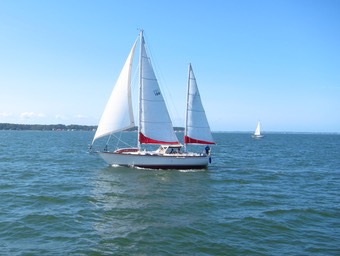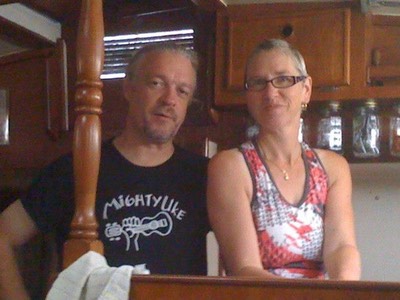The remains of the V-Berth tank can hold two bladders. This requires a shelf. Since the bottom of the tank comes to a tiny little point, it requires two shelves: a top shelf that leaves 11″ of space and another shelf, 11″ below that.

I’ve cut and messed around with some supports. I put them in with tape to see how it might work.
Once we have the supports in there permanently, we can cut a series of trapezoidal panels to make up the berth for supporting the tank.
The lower tank’s triangle (barely visible) is 14″ wide and 15″ along the bottom seam of the tank. The berth is not very big, but the bladder lays on this as well as the sides of the tank, so the bladder will be larger than 14″×15″.
The upper bladder’s bunk will be three sections, each about 13½” tall. One narrows from a base of 35″ down to 24″. The next narrows to 13″. The last will be almost a triangle; we’ll truncate the point and inch shy of the seam in the tank.
We cut a piece of cardboard to see what one of the bunks will look like. Without having the supports firmly attached, it’s premature to measure and cut the shelves.

Here’s the trapezoidal shelf pattern sitting on the supports.
The bladder can then sit on top of this shelf.
The space overall is nearly 39″ long, and three 13½″ pieces will fit leaving a little space up front for condensation, or leaks, to trickle down to the bilge.
The wooden supports need a thorough coating of bilge paint. We did the first coat this weekend.
It’s barely 16°C (61°F) so the paint will take over 24 hours to dry.
As of Sunday, the first coat is on. Next week, another coat of bilge paint on Saturday, and we can install the supports Sunday.

This will let us fine tune the cardboard pattern for the first panel.
So far, things seem to have been working out more-or-less acceptably. Not particularly good, but — more important — not particularly bad.
The cutting was a lot of loud work. But that’s in the past. I’m starting to put the tools away.
Measuring is fraught with difficulties because of the complex shape. I’ve stuck my measuring tape down there over and over to try and get sizing information. It’s difficult.
I think I have the right self-tapping screws to hold the wooden supports to the aluminum tank wall. Ideally, we’ll put these in next Sunday. Then we can start fitting cardboard patterns for real. We can cut and bilge paint the bottom panel, and start ordering some more parts.
Once the bottom panel has two coats of paint, I need to set the 14.5 gallon bladder down in the bottom, and see how things are working. This will involve building the full fill-and-drain setup for the single tank. As soon as the dock water is on, we have to thoroughly pressure test the lower bladder before we install the upper. It’s pretty well inaccessible down there.
I don’t want to get too far ahead of the lower bladder installation, in case there are changes we need to make.


